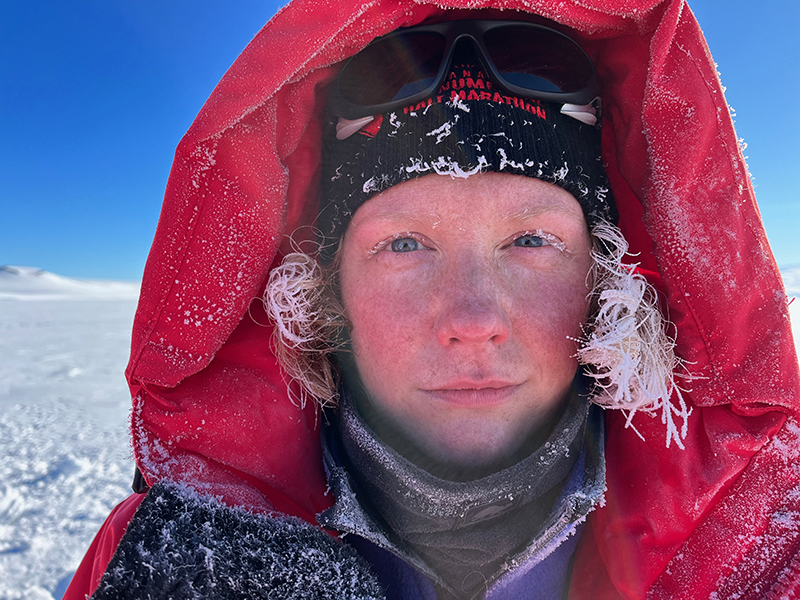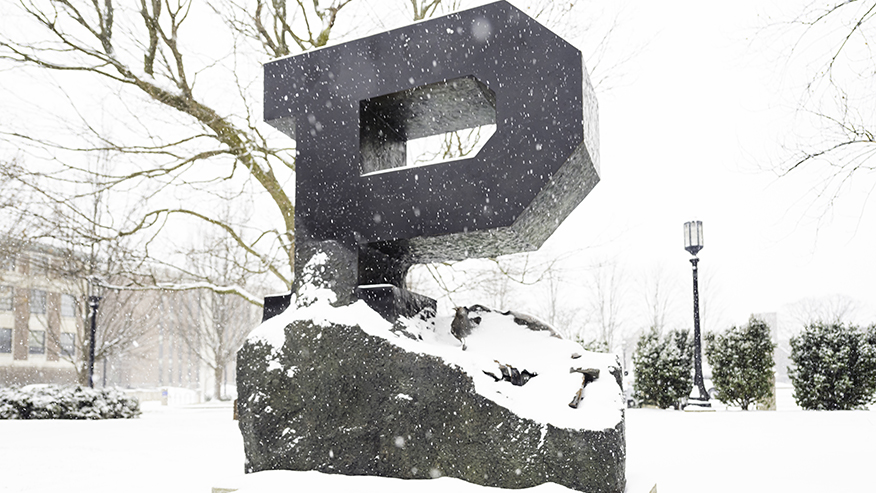Speaking stones: Analyzing Antarctica’s rocks to explore Earth’s past and possible futures.

Marissa Tremblay, assistant professor of earth, atmospheric, and planetary sciences at Purdue University and an expert in geochronology, led an all-woman team of researchers into the wilds of Antarctica to research the climate history of the continent – and the planet. (Purdue University photo courtesy of Marissa Tremblay) (Purdue University photo/Marissa Tremblay, Purdue University)
WEST LAFAYETTE, Ind. —
The standard image of Antarctica is vast, featureless sheets of ice and blowing blizzards. But soaring rocky mountains with deep valleys cut like a knife into the continent of Antarctica, evoking the lavish landscapes of the American Southwest’s Monument Valley. Here, ancient rocks reach for the cold blue sky, and here is where Marissa Tremblay, assistant professor of earth, atmospheric, and planetary sciences in Purdue University’s College of Science, led her team of science experts – all of whom happen to be women.
Their goal in traveling to what is essentially the ends of the Earth was to look far into the past of Antarctica’s climate history. Researchers have long examined ice cores to understand the climate history of Antarctica, but that research can go only as far back as the oldest ice they can access.

To dig deeper into the past – to learn more about some of Earth’s warm periods, when Antarctica lost much of its ice – scientists need to look to the rocks.
Tremblay is a noble gas geochemist who has pioneered a new way of looking at rocks and analyzing what temperatures they have experienced using tiny amounts of noble gas inside the rock. She has already used this technique to study climate history in the European Alps and other places, and she hopes that Antarctic rocks will tell an even older story, taking a deeper dive into ancient history.
“One of the most exciting things about this trip – other than the trip itself – is the possibility of revealing how warm the Antarctic continent was before our oldest ice core records,” Tremblay said. “Understanding what Antarctica, and the Earth, looked like in the past can help us peer into and predict potential futures.”

Tremblay and her team trekked into Antarctica’s remote McMurdo Dry Valleys to sample rocks and record the weather, temperature and atmospheric conditions at a number of sites. The rocks here, at one of the driest and most remote places on Earth, are devoid of ice. They have been exposed to the atmosphere, and almost nothing else, for millions of years.
The team included Tremblay’s doctoral student Emily Apel, who is focusing on this research as part of her dissertation; geologist Jennifer Lamp of Columbia University’s Lamont-Doherty Earth Observatory, who oversaw the weather and temperature instruments; and geochemist Marie Bergelin of the Berkeley Geochronology Center, who sampled rocks and helped install the instruments.
The rock samples they collected are being sent in cold storage on a ship to Tremblay’s lab at Purdue. Once they arrive, she will use her unique expertise to analyze the samples and conduct more detailed research alongside Darryl Granger, Purdue geologist and professor of earth, atmospheric, and planetary sciences.
“Three to 3.3 million years ago, carbon dioxide concentrations in the atmosphere were similar to today, and sea levels were 50 feet or more higher – about the height of a five-story building!” Tremblay said. “This required the entire Greenland ice sheet to have melted, as well as a significant portion of the Antarctic ice sheets. Today, ice sheets cover most of Antarctica, but they are vulnerable to climate change. But just how vulnerable are they, and how much will they contribute to sea level rise as our planet continues to warm? Those are the questions we’re hoping to answer with this new research.”
About Purdue University
Purdue University is a top public research institution developing practical solutions to today’s toughest challenges. Ranked in each of the last five years as one of the 10 Most Innovative universities in the United States by U.S. News & World Report, Purdue delivers world-changing research and out-of-this-world discovery. Committed to hands-on and online, real-world learning, Purdue offers a transformative education to all. Committed to affordability and accessibility, Purdue has frozen tuition and most fees at 2012-13 levels, enabling more students than ever to graduate debt-free. See how Purdue never stops in the persistent pursuit of the next giant leap at https://stories.purdue.edu.
Writer/Media contact: Brittany Steff, bsteff@purdue.edu
Source: Marissa Tremblay, tremblam@purdue.edu
Note to journalists:
More photos, video footage and caption information is in a folder on Google Drive



